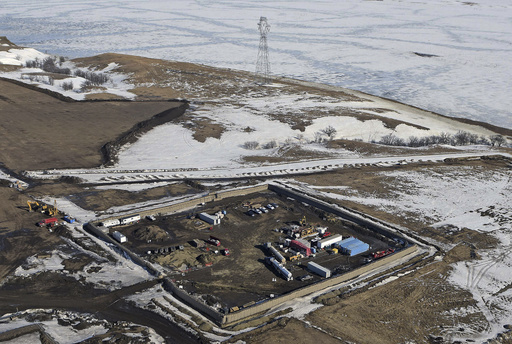BISMARCK, N.D. (AP) — North Dakota stands to gain more than $110 million annually in tax revenue after oil begins coursing through the Dakota Access pipeline, an analysis by The Associated Press shows.
The calculation shows the potential payoff for a state whose officials have supported the pipeline despite concerns from Native American tribes and other opponents who fear it could harm drinking water and sacred sites. The money the state stands to make in just one year far outstrips the $33 million in costs to police a section of the pipeline that’s been the subject of intense and sometimes violent protests over the last year.
“The amount of the windfall to the state doesn’t surprise me at all,” said Payu Harris, an American Indian activist and pipeline opponent. “That’s why the state of North Dakota expended the resources they did.”
Dallas-based Energy Transfer Partners’ $3.8 billion pipeline will carry oil more than 1,000 miles to a shipping point in Illinois and may be moving oil as early as next week. Its completion would be welcome both for drillers seeking a cheaper path to market and for the state government in North Dakota, where declining tax revenue has clouded its budget.
“Every dollar they get extra is good for the state as well,” state tax commissioner Ryan Rauschenberger said.
State budget analysts and an economic consulting firm working on the revenue forecast that lawmakers will use to create a spending plan for the next two years may take the potential tax benefits into account, State Budget Director Pam Sharp said. The new forecast will be released next week.
North Dakota in the past decade has become the second-biggest oil producer in the United States, behind Texas. But its location in the northern Plains, far from major oil markets, means less profit on each barrel of oil. North Dakota lowers its tax on each barrel to keep its crude competitive with other states.
Much of North Dakota’s oil is shipped by truck or train. The 1,200 Dakota Access pipeline would carry the oil through South Dakota and Iowa to a shipping point in Illinois. It could shave shipping costs by more than $3 a barrel, according to Ron Ness, president of the North Dakota Petroleum Council. State tax officials estimate every dollar saved means about $33.6 million in added tax revenue each year.
“Every dollar back is a win for producers, the state and mineral owners,” said Ness, who called the Dakota Access pipeline the most important infrastructure project in North Dakota since the interstate highway system.
It also will link to pipelines serving Gulf Coast refineries, which pay premium prices for high quality sweet crude like that drilled in North Dakota.
In addition to oil tax revenue, the pipeline is estimated to generate $55 million in property taxes annually in the four states it crosses, including more than $10 million a year in North Dakota, said Rauschenberger, the state tax commissioner.
That will provide much-needed revenue to rural counties, he said.
“It’s going to benefit schools and counties and more valuation means lower property tax bills for everybody,” Rauschenberger said.
The pipeline was first announced in 2014, days after then-Gov. Jack Dalrymple, a Republican, urged that more oil and gas pipelines be built to reduce hazardous truck and oil train traffic and to curb the flaring — or burning off — of natural gas at wellheads.
Dakota Access sailed through the state’s approval process, only to run into resistance from the Standing Rock Sioux, whose reservation straddling the North Dakota-South Dakota border is near the pipeline’s route. The Standing Rock Sioux and other tribes urged the U.S. government not to allow the project to move forward and fought the pipeline in court and with protests at a nearby encampment on federal land that at times grew to include thousands of people.
The opponents were dealt a devastating setback in January when President Donald Trump signed an executive order to advance the pipeline’s construction. The Army subsequently gave approval for ETP to put the last final big chunk of pipe under a Missouri River reservoir near the Standing Rock Sioux Reservation. The Army has authority over that stretch because its Corps of Engineers manages the Missouri River.
Authorities last week cleared the last vestiges of the protest camp ahead of spring flooding, although the Standing Rock and Cheyenne River Sioux continue to fight the project in court.
Copyright 2017 The Associated Press. All rights reserved. This material may not be published, broadcast, rewritten or redistributed.







Should save that money to clean up the oil spills…
There is a lot of BS wrapped around this pipeline job.
The only part left to hook up will take maybe a week or 2.
The pipe is already laid out on the job.
whether it’s bore a hole under the river or just dig the 7 ft deep ditch it doesn’t take long.
Side booms will set the pipe and the welders do the joints and the bulldozers will backfill and clean it all up.
Fill the pipe with water to settle it.
drain and clean it with air pressure and shooting giant sponges thru it.
Air pressure test it.
Get the product flowing.
It happens fast…
Sure a group of workers will blast through the job, make a ton of blood money in a short time and then be gone.
A few maintenance workers will be hired to watch the computers run everything.
Then it’s over till the leak or explosion happens.
How do I know this stuff?
100 hrs /week on same type of job. natural gas out of canada, same pipe, same installation process, same blood money.
I use to dig the ditch.